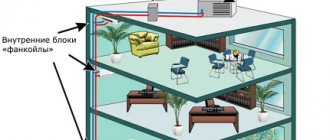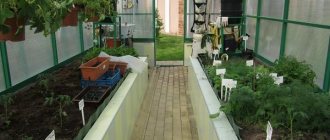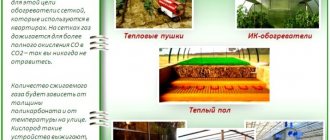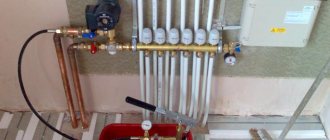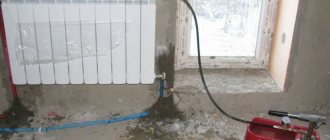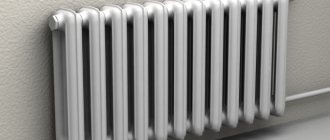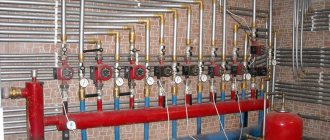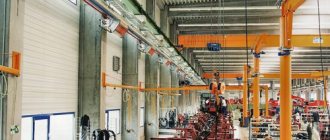Heating options
Most heating systems are quite powerful and it is advisable to use them only in those structures that are used not only in early spring, but throughout the year.
Common Heating Methods:
- oven;
- heating cable;
- gas gun;
- water;
- boiler;
- electric heaters.
A water heating system is more often used for large greenhouses Source stroyfora.ru
Gas guns are considered a good method of heating, which are small in size, quickly warm up the room with minimal fuel consumption, are safe to use and very efficient. Using electricity, it is recommended to use infrared heaters as the main heating element, which do not dry out the air. For year-round and large greenhouses, it is preferable to use brick ovens, since they take longer to heat up, but retain heat well and then cool down for a long time, maintaining a stable temperature. The air will not dry out, the humidity remains at the required level. The metal heats up quickly, but as long as there is fire, such a furnace has a small heat capacity and dries out the air; it is additionally recommended to use a water circuit.
Metal furnaces
Recommended for greenhouses used in spring and summer. They have certain features that make them a better option compared to brick models:
- mobility and the ability to be used for several months, and then it can be removed;
- no foundation required , take up minimal space;
- favorable cost of material;
- possibility of connecting a water circuit ;
- simple and quick installation.
Mobile metal furnace for air heating Source th.decorexpro.com
However, it is impossible to automate the processes and must be heated manually; installation of a container with water is required. The furnace is installed inside the structure or in a separate room with a circuit outlet. The chimney can be located in a greenhouse with a slope of at least 15 degrees. For this purpose, an uninsulated metal pipe is used; thermally insulated boxes are installed in the roof for the exit.
Installation of the furnace is carried out in several stages :
- preparation of the base;
- installation of the stove on the base;
- connecting the chimney using heat-resistant sealant; the chimney should not be allowed to narrow;
- circuit connection, if required.
Furnaces equipped with a water heat exchanger must not be operated without a filled system.
Brick kilns
Heating for a greenhouse using a brick stove is mainly used for year-round use. This heating model is effective even in very cold weather due to its high heat capacity. Any stove can be used, but its thermal output is fully consistent with the heated area.
A brick kiln is a permanent structure designed for many years of operation Source teplicno.ru
Brick laying occurs according to the following scheme:
- creating a high-strength foundation with reinforcement, for this, part of the soil is removed, the bottom is filled with sand, formwork is made, drying takes at least three weeks, the surface must be constantly moistened;
- masonry of the firebox, ash pit, smoke ducts.
The masonry stage has its own difficulties and characteristics, so the work must be entrusted to a qualified specialist who has relevant experience. During the work process, it is necessary to install doors and dampers.
See also: Catalog of companies that specialize in the installation of metal structures.
Water heating
This option can be implemented in several ways - installing a separate boiler or connecting to a house system. In the second case, a separate circuit is made to turn it off and drain the water. If a separate system is being installed, then you will need to install the boiler taking into account the available and profitable fuel.
Gas models are the most convenient and economical; they can maintain the desired temperature. Combustion products are removed through a coaxial chimney. Solid fuel models can have different modifications. Also an economical option, but there is practically no possibility of automation and constant monitoring is required. Electric models that maintain temperature around the clock have greater automation rates. They are small in size, safe and absolutely silent. However, there is a disadvantage - the cost of electricity.
Whatever the stove is used, the operating principle of water heating remains unchanged Source fermer.ru
Such heating in a greenhouse occurs according to one scheme, regardless of the boiler. The following elements are required :
- filters, safety group, pump;
- radiators, pipes, expansion tank;
- balancing valve;
- heat accumulator.
The connection is made according to the following scheme:
- Boiler . It is recommended to be placed in a separate special room for solid fuel models; others are located in the greenhouse itself.
- Chimney . Only for gas and solid fuel models.
- Radiators . Heating elements.
- Buck . Used for a forced system, installed in front of the pump or boiler outlet.
- Security group . Includes air vents, valves, gauges, manifolds and couplings. It is installed behind the boiler, where the highest pressure and temperature are observed.
- Pump . Maintains pressure in the entire system and is mounted in front of the boiler on the return line.
- pressure testing .
If the system has passed the test, then coolant is poured into it and the boiler and a test run is carried out, the air is bled off, and balancing is carried out.
Biological heating of a greenhouse
This type of heating is installed when creating beds in a greenhouse. Under a 20-30 centimeter layer of soil, 30-60 cm of biofuel is placed: manure, peat, straw, and other organic material. It gradually burns inside, releasing heat and supplying plants with nutrients.
Previously, horse manure was used as biofuel, as it was the hottest, but at the same time they were afraid not of frost, but of the fact that the plants would freeze. It was impossible to ventilate on a very windy day; the heat was immediately blown out. The manure burns all the time, raising the temperature, and it is impossible to regulate it. You can mix it with straw, this will slow down the combustion process, lower the temperature, and the biofuel will work longer.
Another disadvantage is that this is a rather labor-intensive process that involves a lot of excavation work. But if everything is done correctly, the soil will be warm even in frosty weather.
The advantage of this fuel is not only warmth for the soil, but also nutrients for plants. In addition, evaporation produces moisture, which will reduce watering.
Choosing the optimal boiler
It is necessary to select a boiler model taking into account the size of the installed greenhouse, as well as the crops being grown. If there is gas, then it is better to use gas models. For year-round models, solid fuel boilers are a good option. For small greenhouses with periodic use, installing a solid fuel boiler is not suitable. It is much more profitable to install a low-power electric one. It does not require space or the construction of a chimney, and electricity costs are minimal.
When using radiators, a number of calculations are required. To achieve a good result and maintain a constant microclimate, you should contact a specialist. In this case, the following are taken into account :
- dimensions of the building;
- thermal power ;
- number of radiators.
The sections must be distributed throughout the greenhouse in several rows. It is better to opt for low radiators for good soil heating.
Water heating using radiators Source th.decorexpro.com
Air heating of a greenhouse
Air has very good thermal insulation properties, so when building a greenhouse it is worth using polycarbonate or considering double glazing.
It is necessary to install air ducts in the greenhouse to ensure uniform heating of the soil and air.
Air heating circuit
It can be heated using wood, gas or electricity. There are several ways to set up such a system.
- The simplest and most primitive option would be to supply air heated from a fire . To do this, a pipe is installed in the center, the diameter of which should be approximately half a meter and the length - 2.5 meters. One end extends outside the greenhouse and hot air is supplied to it.
- You can use a heat generator , which supplies warm air thanks to a polyethylene sleeve. It is mounted on the ceiling and is complemented by perforation. The main disadvantage of this option is the inability to provide high-quality heating of the soil with air.
- Another way is to use a gas convector . It creates an air flow that circulates throughout the greenhouse. The disadvantage of this method is that gas pipes must be laid out, and the plantings must be placed at a sufficient distance from the convector. In addition, this method burns oxygen, so it is necessary to consider ventilation.
- You can use thermal devices - a fan, a heat gun . To prevent damage to the plants, the pipe is laid under the beds and in a certain place is brought outside, where a heat source is attached to it.
DIY heating in a 5th generation greenhouse
Innovative technology in 5th generation greenhouses provides for the distribution of air flows through air hoses, providing precise climate control. The concentration of CO2 is uniform throughout the greenhouse, temperature deviations in both horizontal and vertical planes are 1-2 Co, which in itself is a serious technological achievement.
Air flow distribution in a 5th generation greenhouse
This technology can reduce heating costs by 25%.
Gas heating of the greenhouse
Systems providing this type of heating can be divided into three types:
- Infrared.
- Catalytic.
- Convector.
Gas-air and gas-water systems can also be distinguished. Heaters with open burners, convectors and systems with infrared burners are optimal for greenhouses.
Open burner heaters
The design includes a thermostat, main and pilot burners. The system is connected to a gas cylinder. The disadvantage of this method is that oxygen is burned, so installation of ventilation is required.
Gas convectors
Such equipment consists of the following parts:
- Fire resistant housing. It must be heat resistant.
- A heat exchanger that heats the air.
- Gas burner located inside the heat exchanger.
- Combination valve that regulates pressure.
- A system that removes combustion products.
- Thermostat that controls the microclimate.
- Automation that controls the operation of the system.
Combustion products can be removed using two different systems.
The fireplace system includes a vertical chimney, which serves to remove combustion products to the outside.
Parapet system - combustion products enter a coaxial pipe, which is laid through the outer wall.
Gas heaters with infrared burners
This design is ideal for heating a large room. When choosing equipment, you need to choose those heaters that are intended for outdoor use.
Such a device consists of the following parts: a cylinder-shaped body in which a gas cylinder is built; stand and hose for connecting the cylinder and burner; a mesh with a large cross-section and a cylindrical shape, a control panel is attached to it; gas burner umbrella.
The device runs on propane. Only 11.5 kg will provide 15 hours of trouble-free operation.
An important difference between heaters of this type is that it is not the air that is heated, but objects located at a certain distance.
How to pipe gas into a greenhouse with your own hands
It is important to remember that connection to the main gas pipeline should only be carried out with the involvement of the appropriate services. Here any independent actions are prohibited.
To install gas heating in a greenhouse with your own hands, it would be optimal to choose the option with infrared burners. First, you need to think about where the device will be mounted - on the floor, walls, parapet.
Then ventilation is installed, which can be assembled from PVC pipes.
After this, the equipment is installed. It is important to follow several rules:
- There should be a distance of 1 m from the soil to the device.
- The same distance is maintained from the plants to the device.
- Several infrared devices are located no closer than half a meter from each other.
After this, a hose is connected to the reducer on the cylinder, the second end of which is fixed to the device. The joints are strengthened with clamps.
Selecting a heating system
When choosing a greenhouse heating system, you should consider:
- building dimensions
- heating method for a residential building
- your financial capabilities.
Each option has its own advantages and disadvantages.
It is important that the heating system matches the type of greenhouse.
It is known that heating film greenhouses, for example, requires more heat release than heating greenhouses made of polycarbonate - a material that itself is a worthy heat insulator.
It is necessary to take into account the features of the system. For example, some of them, due to their high cost, are completely unsuitable for standard, small-area greenhouses. Other systems require professional installation and configuration.
This is especially important when it comes to heating industrial greenhouses, where advanced technologies are used, such as heat pumps, infrared heating and others.
Having decided on homemade greenhouse heating, the first thing you need to do is “feel” the entire process technology, take into account all the pros and cons of the selected heating system.
It is necessary to correctly calculate the heating of the greenhouse in order to achieve the most rational distribution of heat in a given room.
Now briefly about each heating method.
Steam heating of a greenhouse
The main advantage of this method is the uniform heating of the greenhouse, which has a beneficial effect on the plants. The air is heated with the help of steam, which appears after the water in the boiler boils.
Hot air enters radiators connected by pipes.
Composition of the steam heating system:
- boiler for heating water;
- Exhaust valve;
- radiators;
- pump;
- pipes;
- firebox
Connecting the furnace to the foundation of the greenhouse through cutting
The system can be of two types - closed and open. In the first option, the condensate is returned to the boiler using a special pump. If the second option is used, the pipes are made with a slight slope and the condensate enters the boiler on its own.
The system can be high pressure (from 170 to 600 kg/m2), low pressure (from 100 to 170 kg/m2) or vacuum-steam. This parameter is affected by the length of the pipes and some other characteristics of the system.
The pipe layout can be single-pipe, when both steam and condensate are in the same pipe, or double-pipe, when steam and condensate are separated, but both pipes form a closed cycle. The second option is preferable because it is possible to regulate the temperature by turning the valve.
Such a heating system can operate on wood, coal, fuel oil, diesel fuel or natural gas. Boilers also differ. They can be gas-tube, which have low power, or water-tube, which are safer.
Water tube boilers can be vertical (drums are located at different height levels) or horizontal (drums are equipped with manifolds). The boiler consists of a burner, firebox, ash pan and drum.
What to pay attention to during installation
- It is necessary to install only metal pipes, since plastic ones cannot cope with heavy loads.
- Particular attention should be paid to reliability. All components must be manufactured at a trusted factory.
- It is necessary to correctly calculate the boiler power.
Electric heating of the greenhouse
There are several options:
- Air: heat guns, fan heaters or oil radiators.
- Water: boilers with heating elements operating on electrodes or on the induction principle.
- Infrared electric heaters (differ in that they heat objects rather than air, reducing electricity costs by 30%);
- Heating cables that are laid directly into the soil.
We have already talked about the first three options earlier in the article, now we will consider the last method of heating the greenhouse - using a heating cable.
Heating cables can be of various types:
The first type is resistive cables. They are quite inexpensive, but can lead to either overheating of the soil or insufficient heating.
Resistive cable
The second type is a self-regulating cable. It consists of two carbon cores that are separated by a semiconductor. It saves energy and regulates soil heating.
Self-regulating cable
Cable system installation
The better the cable is laid, the more efficient the system will work. Its arrangement involves the following stages:
- It is necessary to remove a layer of soil of about half a meter.
- Sprinkle some fine sand. The thickness of the pillow should be about 5 cm.
- Lay thermal insulation, for example, penoplex.
- Lay waterproofing - polyethylene.
- Sprinkle another 5 cm of sand on top.
- Lay down fine mesh metal mesh.
- Then the cable is laid in the form of a snake. It is important to maintain a step of approximately 20 cm.
- The cable can be secured with plastic clamps.
- After this, 5 cm of sand is poured again.
- The structure is covered with a protective mesh made of plastic or stainless steel.
- Now you can lay 40 cm of soil.
- The sensor, with which the temperature will be regulated, is mounted about a meter above the soil surface.
Stove heating of a greenhouse
The main source of heat in this case is a solid fuel boiler that runs on wood or coal (Buleryan-type stoves have become popular recently).
Greenhouse stove
The easiest way is to install a boiler and a pipe that will remove smoke and combustion products. You can add pipes and radiators, then the quality of heating will increase significantly. We must remember that the chimney must be promptly cleaned of ash and soot.
One of the disadvantages of this option is excessive drying of the air. To maintain the required level of humidity, you can simply place a large container filled with water in the greenhouse.
Stove heating
An important advantage of such a system is its ease of installation, which even an inexperienced technician can handle. In addition, stove heating is much cheaper than electric heating.
Stove heating of a greenhouse: step-by-step instructions No. 1
Stoves for greenhouses
First stage . In the vestibule of the greenhouse it is necessary to build a foundation, on which a brick firebox is then laid.
Brick oven with hog
Second phase . A chimney is laid out along the entire length.
Hog base and blower chamber with air intakes located on the side
Firebox and chimneys
Third stage . A smoke exhaust pipe is installed on the opposite side of the greenhouse. Thanks to this design, all combustion products will be removed, and the room will remain warm.
Continuation of the firebox and covering the hog Connection of the furnace to the foundation of the greenhouse through cutting
Water tank mounted above the firebox
Garden bed located directly on the stove
Ready oven in a greenhouse
Stove heating of a greenhouse: step-by-step instructions No. 2
Heating system diagram:
- 1 - heating boiler;
- 2 — thermos tank;
- 3 - circulation pump;
- 4 - relay regulator;
- 5 - registers;
- 6 - thermocouple.
First stage . You will need a large metal barrel. Its internal surface must be protected from corrosion. To do this, you need to paint it, preferably in two layers.
Second phase . Several holes are punched in the body. One of them will be needed to connect the chimney, the others for the tap and expansion tank.
Third stage . It is necessary to weld the stove itself, for which sheet metal is used. Next it is inserted into the barrel.
Fourth stage . A piece of pipe is welded to the hole in the barrel intended for the chimney. The total length of the smoke exhaust structure must be at least 5 meters.
Fifth stage . An expansion tank is mounted on the barrel. The optimal capacity is 20-30 liters.
Sixth stage . There are pipes throughout the room. They can be laid out directly on the ground, observing a step of 1.2 meters.
The seventh stage - a pump is installed to ensure the movement of water in the system.
Solid fuel boiler in a greenhouse
After the entire system is assembled, you need to turn on the water and check the tightness of all joints. If there are leaks, they must be repaired immediately. After this, you can check the operation of the oven.
